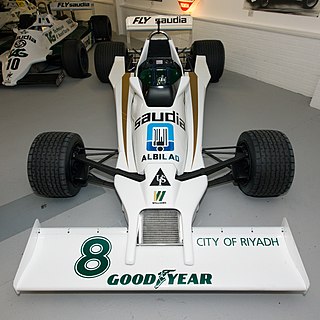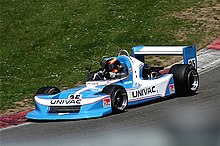
Formula Two is a type of open-wheel formula racing category first codified in 1948. It was replaced in 1985 by Formula 3000, but revived by the FIA from 2009–2012 in the form of the FIA Formula Two Championship. The name returned in 2017 when the former GP2 Series became known as the FIA Formula 2 Championship.
Lola Cars International Ltd. was a British race car engineering company in operation from 1958 to 2012. The company was founded by Eric Broadley in Bromley, England, before moving to new premises in Slough, Buckinghamshire and finally Huntingdon, Cambridgeshire, and endured for more than fifty years to become one of the oldest and largest manufacturers of racing cars in the world. Lola Cars started by building small front-engined sports cars, and branched out into Formula Junior cars before diversifying into a wider range of sporting vehicles.
March Engineering was a Formula One constructor and manufacturer of customer racing cars from the United Kingdom. Although only moderately successful in Grand Prix competition, March racing cars enjoyed much better success in other categories of competition, including Formula Two, Formula Three, IndyCar and IMSA GTP sportscar racing.

The McLaren M23 was a Formula One racing car designed by Gordon Coppuck, with input from John Barnard, and built by the McLaren team. It was a development of the McLaren M16 Indianapolis 500 car. A Ford Cosworth DFV engine was used, which was prepared by specialist tuning company Nicholson-McLaren Engines. This helped push the DFV's horsepower output to around 490 bhp.

The Ferrari F2002 was a racing car used by Scuderia Ferrari Marlboro as its entry for competition in the 2002 Formula One season. The chassis was designed by Rory Byrne, Ignazio Lunetta, Aldo Costa, Marco Fainello, Nikolas Tombazis and James Allison and Paolo Martinelli, assisted by Giles Simon leading the engine design and operations, under the overall leadership of Ross Brawn who was the team's Technical Director and Jean Todt the team Manager. It won fifteen Grands Prix, from a total of nineteen races in 2002 and 2003. It is widely regarded as one of the most successful Formula One car designs of all time, as Michael Schumacher drove it to a then record-equaling fifth world drivers' title in 2002, while easily clinching the 2002 constructors' title with as many points as all other teams put together.
Formula BMW was a junior racing formula for single seater cars. It was positioned at the bottom of the motorsport career ladder alongside the longer established Formula Ford category. Like Formula Ford, it was intended to function as the young kart racing graduate's first experience of car racing.

The Maserati 4CL and its derived sister model the Maserati 4CLT are single-seat open-wheel Grand Prix racing cars that were designed and built by Maserati. The 4CL was introduced at the beginning of the 1939 season, as a rival to the Alfa Romeo 158 and various ERA models in the voiturette class of international Grand Prix motor racing. Although racing ceased during World War II, the 4CL was one of the front running models at the resumption of racing in the late 1940s. Experiments with two-stage supercharging and tubular chassis construction eventually led to the introduction of the revised 4CLT model in 1948. The 4CLT was steadily upgraded and updated over the following two years, resulting in the ultimate 4CLT/50 model, introduced for the inaugural year of the Formula One World Championship in 1950. In the immediate post-war period, and the first two years of the Formula One category, the 4CLT was the car of choice for many privateer entrants, leading to numerous examples being involved in most races during this period.

The Williams FW06 was the first car produced by the combination of Frank Williams and Patrick Head for their Williams Grand Prix Engineering Formula One team. As was the standard arrangement for the many small British garagiste teams, the car was powered by the Cosworth DFV 3.0 litre V8 engine.

The Lotus 69 was an open-wheel formula racing car developed by Lotus in 1969 for use in Formula 2, Formula 3, and Formula Ford.

The Brabham BT23 was a formula racing car built by Brabham in 1967.

The Cooper T86 was a Formula One racing car built by Cooper and first raced in 1967. B and C specification cars were also built to accommodate different engines, but the car could not revive Cooper's fortunes and this type represents the last Formula One chassis built and raced by the former champion team.
The March 722 was a British open-wheel formula race car chassis, designed, developed and built by March Engineering, for both Formula 2 and Formula B racing categories, in 1972.

The Cooper T23, formally called the Cooper Mk.II, is a Formula 2 racing car, built, designed, and developed by British manufacturer Cooper Cars in 1953. It also competed in Formula One, in 9 Grand Prix between 1953 and 1956. It was powered by the Bristol six-cylinder 2-litre engine.
The March 693 was a Formula 3 racing car built and used by March Engineering in 1969. It was powered by a naturally aspirated, 997 cc, Ford 105E straight-four engine, producing 120 hp (89 kW), and weighing in at a tiny 400 kg (880 lb).

The March 783 and March 793 are open-wheel Formula 3 race car chassis, designed, developed, and built by March Engineering between 1978 and 1979. They are very similar in design, with the 793 essentially being a ground effect version of the 783; with lower side pods and skirts. Between them, they won a total of 24 races, including three non-championship races in 1979, with Kenny Acheson. The 793 chassis in particular was extremely successful, and completely dominated the 1979 season, with Brazilian Chico Serra clinching the 1979 British Formula Three Championship, after winning 5 out of the 20 races. Italian Andrea de Cesaris was runner-up, placing second in the championship; having also won 5 races with the March 793. New Zealander Mike Thackwell placed third in the championship, having won 4 races with the March 793 chassis. They were powered by either a Toyota or Triumph four-cylinder engine.

The Sauber C5 is a Group 6 prototype racing car, designed, developed and built by the Swiss Sauber team, specifically made to compete in the 1977 24 Hours of Le Mans and the 1978 24 Hours of Le Mans. It is powered by a naturally aspirated 300 hp (220 kW) BMW M12 four-cylinder engine. It scored 15 race wins, 31 podiums, clinched 1 pole position, and 6 wins in its class. With these statistics, it makes it one of the most successful early Sauber sports cars.

The Chevron B16 was a Group 4 sports prototype race car, designed, developed, and built in 1969 by the British racing car manufacturer Chevron Cars as a two-seater racing sports car for the makes world championship. Brian Redman won the very first outing, the 500 km (310 mi) race at the Nürburgring on September 7, 1969, at a time of 3:13:01.6 hours. The last victory with a Chevron B16 was achieved by Clemens Schickentanz on July 11, 1971, in the sports car race at the Norisring.
The Chevron B6 is a lightweight sports racing car, designed, developed and built by British manufacturer Chevron Cars, in 1967. Only 7 cars were built, which makes it very rare. Over its career, spanning 8 years, it won a total of 15 races, plus 4 additional class wins, clinched 1 pole position, and scored 30 total podium finishes.

The Gordini T32 was an open-wheel formula racing car, designed, developed and built by French manufacturer Gordini, for the 1955 and 1957 Formula One World Championship seasons.













